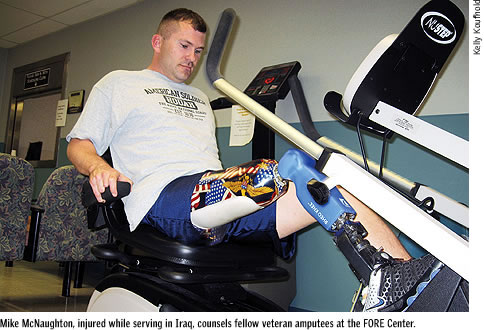As recently as the 1991 Gulf War, one
out of every four soldiers wounded in battle died of
their injuries. Now,
thanks to dramatic improvements in equipment, training,
and battlefield medicine, nine out of ten wounded soldiers
will survive.
That means more veterans living with serious
injuries. Like amputations.

There are at least 26,000 American veterans
living with amputations, according to the Department
of Veterans
Affairs, and the VA has been a world leader in helping
people survive and recover from the loss of a limb.
That’s the purpose behind the new Functional Outcomes
Research and Evaluation (FORE) Center at the Miami Veterans
Affairs Healthcare System, the brainchild of Robert Gailey,
Ph.D., P.T., an associate professor in the Department
of Physical Therapy at the UM Miller School of Medicine.
“We’re trying to create a state-of-the-art
research and rehabilitation center,” says Gailey,
who has worked for the University for 20 years and with
the government
since 2001. “It doesn’t look like their father’s
VA.”
The FORE Center, as it’s called, is designed for
two purposes. Job one is to help the veterans with below-the-knee
amputations improve their mobility and independence by
analyzing what problems they’re having and customizing
a rehabilitation program to improve them. But the second
priority is also important—learning what works,
documenting it, and disseminating what is learned.
The staff at the FORE Center is recording
tremendous improvement by the end of the eight-week program.
“Our guys are getting better, they’re getting
faster,” says
Gailey. “And we know that if a person remains active,
they stay healthier and have less impact on the overall
health care system.”
More than 500 United States veterans have
lost limbs to battlefield trauma in Iraq and Afghanistan,
but many
tens of thousands more will lose them to diabetes and
peripheral artery disease. The mission of this new
center is to help these veterans function as closely
to normal
as possible—to get them back on their feet. |